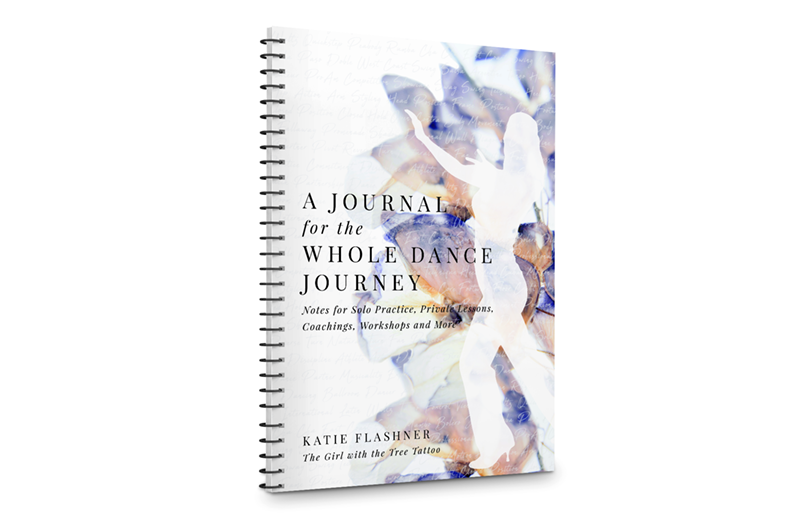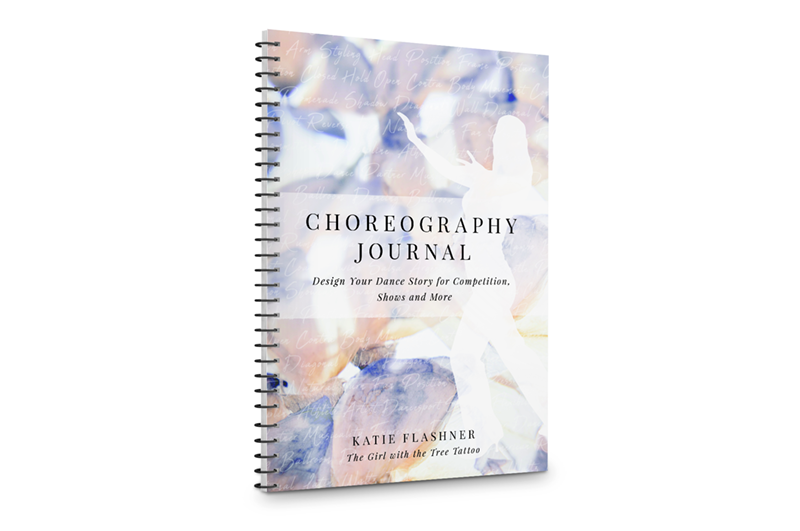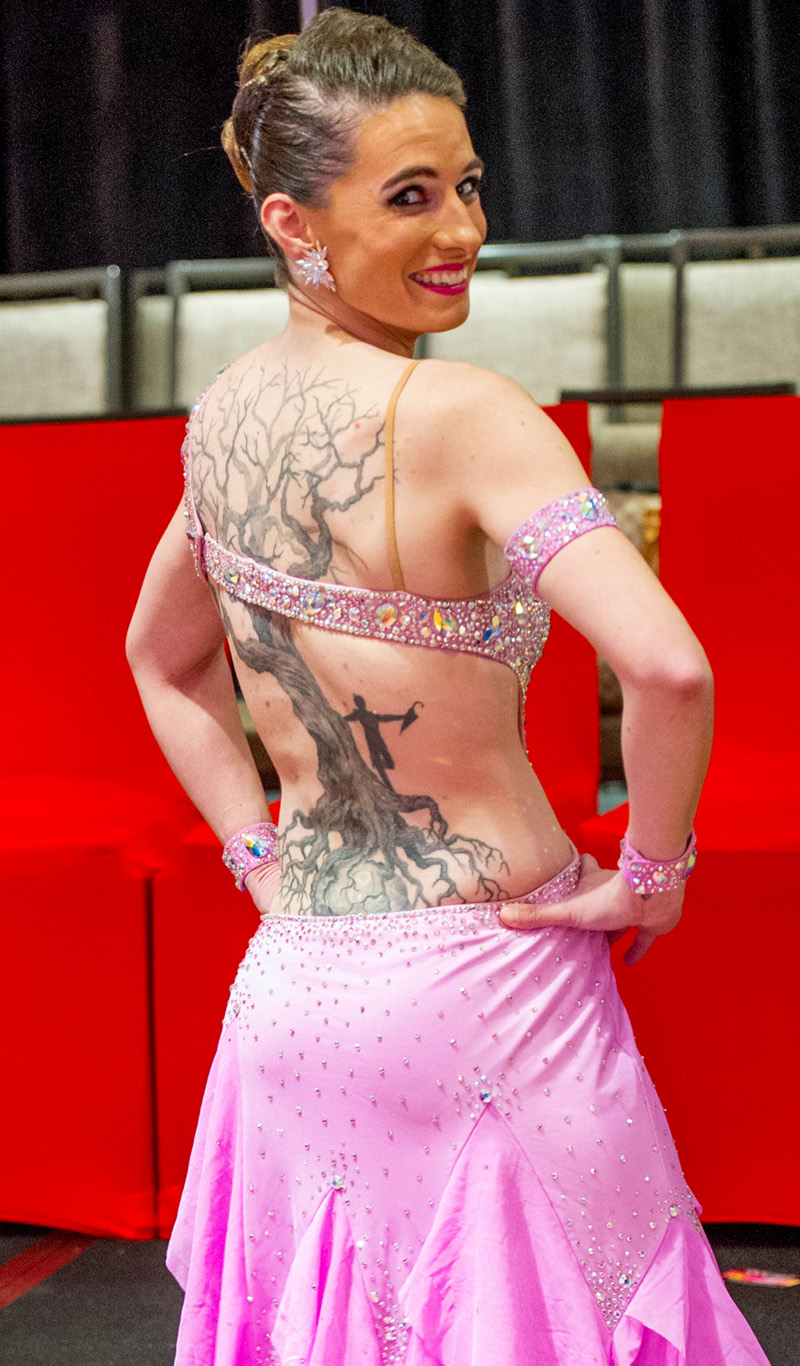Journaling the Whole Dance Journey
An Interview with Katie Flashner
BY EMMALY WIEDERHOLT
Katie Flashner is a ballroom dancer based in Southern California. Her blog, The Girl with the Tree Tattoo, offers inspirational stories and practical guidance for the Pro-Am ballroom dancer. She recently published two books – A Journal for the Whole Dance Journey and The Choreography Journal. Here, she described how and why she created these two books, as well as how she hopes they serve dancers at any level or in any genre by giving them a framework to reflect, motivate, learn and improve.
~~
Can you share a little about your dance practice – how did you get into dance, and what have been some highlights from your dance history?
I started ballroom dancing in 2012. My coworker introduced me to the studio where I still train today. Once I tried it, it stuck. In 2013, I started training with my current teacher, who has also been my competitive partner since 2014. We compete together in what’s called the Pro-Am circuit, which stands for “professional-amateur.” We compete in the American smooth style, which consists of waltz, tango, foxtrot and Viennese waltz. I’m humbled and proud to say I’ve always done well. In competitions, I almost always place second or first, or at least in the top three.
2017 was an unusual year. I did three competitions that year, and in each competition I placed lower. In the Embassy Ballroom World Championships, I placed fifth out of seven couples, placing me in the bottom three. That was a major blow to my ego, but it also became the catalyst for my last book, The Solo Practice Guide for Ballroom Dancing. Ballroom dancing is a partner dance but practicing steps and technique on your own is key. I put all my strategies and the framework I developed in my own solo practice into a book. And these strategies work! I returned to the World Championships in 2018 where I competed in the same division and placed first out of 11 couples, earning me a world title. That’s been the biggest highlight of my dance career so far.
Since then, I moved up a division but only competed once this year. I had knee injuries at the beginning of the year that slowed down my training.
What inspired you to write your two recently published books?
Since publishing The Solo Practice Guide for Ballroom Dancing last year, I’ve wanted to work on my next book, but it’s been hard to pull concrete ideas out of the ether. So I sent out a poll on social media asking my readers what they need next: What are you struggling with? What’s still holding you back?
The response that came up most was organization. The Solo Practice Guide included worksheets for taking notes on solo sessions, but there are still private lessons, group classes, coachings and workshops. Readers responded that their notes were all over the place and it was hard to feel organized. They wished they had all their notes together in one place that was strategically designed. That’s where I got the idea for A Journal for the Whole Dance Journey. I’ve been calling it the dance journal to rule all dance journals. It includes specific design features that address my readers’ concerns, such as a way to easily index your notes. If you’re wondering where your notes are on foxtrot from two months ago, instead of scanning through every page, I created a feature on the side of the pages where you can flip through the book quickly and find the notes you’re looking for.
The Choreography Journal came out of my knee injuries. I was diagnosed with chondromalacia patella, which means the cartilage underneath my kneecaps is wearing down and causing me pain. In the beginning of the year, the pain was enough that I had to pull back from my lessons and practice. Everyone was telling me to rest, but I just wanted to train. I felt like I was falling behind. My teacher challenged me to write out the choreography of our routines as an alternative to going to the studio to practice. I’d never mapped out my choreography on paper before; I usually used videos. But I figured I was a writer and I could do this. It ended up being very challenging. I looked online and found a few systems for writing down choreography, like Labanotation, but I ended up creating my own simplified way. When I shared it with my readers, they really liked it. So I designed a second journal, The Choreography Journal, that was more than a lined notebook that says, “Choreography” on the front cover. It gives dancers a foundation and structure for recording their choreography.
How did you design these books?
I hired a graphic designer to help me. Her name is LeAnna, and Weller Smith Design is her company. I knew her through an entrepreneur group that I’m part of. She had been talking about launching a new service line called Productologie for people who wanted to create a product extension to the services their business offered. I was her first Productologie client. I gave her the ideas and vision, and she brought the design to life.
How would you describe A Journal for the Whole Dance Journey?
When you first open it, there’s a full page that asks you to write out commitments to yourself, both things you’re committing to do and things you’re committing not to do, like, “I won’t only pick out the bad things I see in my dance videos.” Dancers are perfectionists, so we always feel like we need to do more. I want to help people be more self-aware, so they have balance. I don’t want people to always feel like they’re not doing enough. There are also two pages to write out your current status as a dancer, including what has been working for you and what hasn’t, and your intentions or goals moving forward.
Then the meat of the journal is where you record your dance training notes. There are dates at the top of the pages so you can write a page a day, or ignore the dates and use multiple pages for one class. There are also prompts like, “What did you do well today?” or “What do you want to do next time?” They’re present but not obtrusive; if someone needs to journal for five pages, they can just write without the prompts interfering. But if they want the prompts, they are there. There are also four check-in points throughout the journal that prompt you to revisit the goals and intentions you made at the beginning, and then set new ones or reaffirm old ones.
And how would you describe The Choreography Journal?
It’s divided into ten sections. Each section begins with dance floor diagrams. You can sketch out your routine to see how it moves across the floor or stage spatially. Then there’s a blank page for story and character ideas. I made it blank because I wanted readers’ creativity to flow without restrictive lines: What story is the dance telling? What character do you want to embody? After that, there are multiple lined pages. There’s a column of short dashes along the left side of the page, and every third line across the page is also dashed. These design features are meant to give people a place to write out timing, either across the page or down the left side, depending on how much detail people want to go into about the movement for each count. The journal also includes a similar feature as The Whole Dance Journey – a space on the side of the page to write the dance style and name to make it easier to index.
Why do you believe these journals could be useful to any style of dancer?
My exposure to dance is through the ballroom world, but through the little exposure I have had to other styles, I see the common threads. I believe it’s important to make commitments to yourself, to show up, and to not overly criticize. I didn’t want to design the journals specifically around ballroom dances, because any style of dancer could benefit from organizing and structuring their dance notes. I also didn’t want the journals to be too loose in their design. If you look for a choreography journal on Amazon, there’s nothing really structured beyond lined or gridded pages. I wanted to create something with a little more guidance in its design, but that was still flexible enough for any dancer to use.
Are the books intended to be used together?
They certainly can, but they stand on their own. I created the two because I think it’s important to keep routines and choreography separate from day-to-day training. This is influenced by my ballroom background; we have our competition routines, and then we might have practice routines or drills. The master routines can be preserved without getting mixed in with the day-to-day notes.
Are the books intended for all levels?
They are intended for all levels, but I suspect that more professional dancers won’t need them as much as amateur level dancers. I see professionals as having their flow down as far as how they document their training and record their choreography. I’m targeting those who are still finding their way. That’s usually who I’m envisioning when I write for my blog. However, there might be plenty of professionals who could use journals like these! I would love to have created something that could help professional dancers or teachers, not just students.
How have you personally grown through the process of putting together these two books?
So much! It’s fascinating how I’ve evolved as I move along my dance journey and my entrepreneur journey. My dancing and writing complement each other. This past year, having both knees injured and sitting on the sidelines was very challenging emotionally. The journals help me feel like I’m still fulfilling my purpose. If I can’t dance, I can serve other dancers. As I’m going along my own journey, I ask what gaps or struggles I’m running into where there’s not a good resource to help me. With The Solo Practice Guide, there were professional opinions and advice on how to practice alone, but it’s different when you start dancing as an adult and already have a full life. It doesn’t mean you can’t grow as a dancer; you just approach it a little differently. I’m trying to fill in the gap between the teacher and the student. I want to help students handle and cope with all the variables in their dance training.
~~
To learn more, visit thegirlwiththetreetattoo.com.



